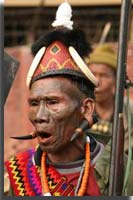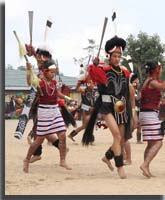History
Originally Nagas were not known as tribes. The Naga tribes are linked with tribes in Assam and Myanmar. From 1816 invasion onwards Assam came under the rule of Myanmar. Naga tribes belonged to Indo-Mongoloid Family.

Some of the major Naga tribes are Angami, Chang, Konyak, Lotha, Phoms, Rengma, Sema, Pochury and Zeliang.
Food
Naga food consists of rice or millet accompanied by vegetables, fish and meat.Nagas are fond of chillies and can fill their mouth with chillies and nothing else as if they were chocolates.
Languages
Nagas speak 60 different dialects belonging to the Sino-tibetan family of languages.
Place /Location (then and now) |
Arunachal Pradesh ,Manipur, Assam and Mynamar |
Population |
100000 - 200000 |
Languages spoken |
Sino-Tibetan |
Food |
Rice, Millets , Vegetables, Fish and Meat |
Location
Naga tribes are found in the states of Arunchal Pradesh, Manipur and Myanmar. Food and clothing
Mundas are animal eaters for a long time. Their usual food inculdes frogs, snakes, rats, earthworms, shells and snails. Mundas prefer having Tari and Haria wine on the various occasions. They are in close touch with the Hindu society. Munda men wear pant and shirts, While the women are seen wearing the cotton saris with the cholis or blouse. Mundari are generally short in height, dark complexion, and good looking. They have short curly hair.
Occupation
Naga tribe burn their fields and grow rice, millets and taro patato. The practice of head-hunting by Naga Tribe is accompanied with a variety of other social and cultural activities. The tribe has stimulated the carving of wooden heads marked with prominent features and mobile expressions which were worn like medals by the proud, successful head-hunters. Dancing, drinking (local rice beer) and merry-making follow the head-hunt. Head-hunting inspired the weaving of special textiles of choice, colours and designs for use as shawls by the head-hunter to identify his heroism. Strong and vigorous figures are carved in bold out of wood and fixed to the baskets of the warriors, indicating the number of heads taken. Such wooden figures were also kept in houses as prized trophies.
People
Nagas are people with great hardwork, sturdy, with a high standard of integrity and strong sense of self respect. Most of the time they are simple means the unspolit children of nature. The most important quality of Naga tribes is their hospitality and cheerfulness to greet people with a smiling face while travelling on the roads is the common experience for every one who notices them. Even today people hunt tigers and elephants in the mountains with spears and bows.
Appearance
The height of all the Naga is medium -sized. The men are muscular and full of stamina. The nose is flattened but some are sharp in their mongoloid features.The women are short but stout. The eyes of women are deep set with bulged eye sockets. Women are fairer in complexion.
Costumes
The Naga tribes are versatile artisans. The design and colour of each group of Naga tribes differs with other group depending on the wearer's position in the society. Every woman is supposed to weave the cloths for her family and carry on the activities like spinning, dyeing and weaving. The Naga shawls are the most famous ones which come in bright colour and various patterns. Colorful ornaments are worn by both men & women which are made of ivory, these ornaments include the bangles and bracelets. The tribe is very much fond of ornaments. Some old men grow hair long and arranged in tangled knots. The babbed hair is the fashion for the young Naga girl. Tattooing is customary for Naga tribes only in North and East.
Culture

Festival
Naga tribes' biggest festival is New year festival of January 15th, called Kaing Bi and organized by Naga festival committee who choose each year's festival location and details under the control of Central government. The Naga tribes send a few delegations to this occasion, thus it is the perfect opportunity to see variety of different Naga people at once.


